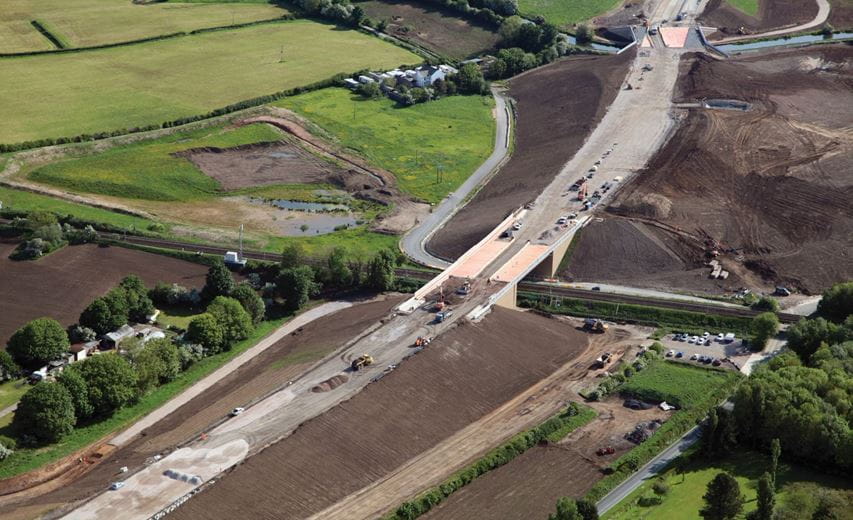Where the use of ‘public works’ creates a physical nuisance which causes depreciation in the value of property, compensation is payable under Part 1 of the Land Compensation Act 1973. This is a form of ‘injurious affection’ and the only basis through which qualifying property owners who are not directly affected by a scheme (i.e. by CPO) can claim for loss.
With the continued political enthusiasm for infrastructure investment and large-scale housing developments needing new roads and infrastructure, ‘Part 1’ should be an important consideration for public authorities, developers and claimants from scheme conception.
Mark Warnett and Phil Tuley of Carter Jonas’s Infrastructure Team consider the budgetary and valuation challenges.
Background
Part 1 compensation is for use of the Public Works only (i.e. not construction or existence) due to physical factors; noise, vibration, smell, fumes, smoke, artificial lighting and the discharge onto land of any solid or liquid substance. ‘Public Works’ are defined as any highway, aerodrome, and any works or land (not being a highway or aerodrome) provided or used in the exercise of statutory powers. Works are not limited to entirely new schemes, but also alterations and extensions. In the case of an aerodrome, this includes where a runway is extended, strengthened or substantially realigned, and, in the case of a motorway, new street lighting is included.
A forgotten cost?
Part 1 claims can only be submitted 1 year after the public works have come into use; usually long after the shovels have been put away and focus has moved onto the next scheme. This is a potential financial risk for all projects as there is a level of uncertainty in the number and quantum of claims (see valuation below) that will be received. Claims can total millions of pounds and, by the time they are received, most projects are completed and may not be in the financial position to pay their liability. The financial liability for compensation lies with the ‘responsible authority’, which will usually be the relevant public body applying the statutory powers. Sometimes liability will be delegated to a developer or partner by contract (e.g. S.106 Agreement).
This underlines the importance of public bodies and developers being both aware of, and planning for the potential cost by taking specialist advice and, where appropriate, property cost estimates. Carter Jonas has been able to assist in cases where the party responsible was completely unaware of their potential liability.
Assessment of compensation
It is usual for valuers to be instructed after the scheme has been built and it relies on the valuer’s skill at valuing an asset in the past, together with their opinion of the depreciation as a result of the use of the road. There are a number of common pitfalls.
The fundamental challenge (common to all injurious affection claims) is lack of comparable evidence. Valuers are dependent on comparable evidence; however, nobody instructs an estate agent to market the reduction in the value of their house due to a 5 decibel increase in road noise. The best evidence is where a property has been acquired ‘pre-scheme’, then marketed or sold after implementation. Such good evidence was (very unusually) available in the Upper Tribunal case Ledburn Properties vs East Cheshire Council for injurious affection following compulsory purchase for a road; coincidently or not, the decision was for a 40% diminution which is very significantly higher than most settlements.
An additional challenge for ‘Part 1’ is that the claim can only be made for loss due to the use of the public works limited to physical factors. In contrast to ‘full’ compulsory purchase injurious affection claims (as for Ledburn above) where the impacts of construction and non-physical factors (like visual effects and reduction in the quality of the local area) can be considered. An adjustment must be therefore also be made to discount unclaimable elements, for which comparable evidence is even less likely to exist.
Over reliance on noise data should also be avoided. Most schemes will undertake noise surveys as part of their planning process and will produce a noise model based on assumptions such as traffic use, topography and weather condition. In Goodman, acoustics experts submitted over 800 pages of written evidence on technical noise issues and gave oral evidence for 8 hours at hearing. However, the Member cited the 1997 King and others v Dorset County Council 1 EGLR 245:
“it should be borne in mind that the task of the Tribunal is to determine the depreciation (if any) of the value of the claimant’s interest. That is a matter for the market, and as (counsel for the claimant) observed, the bidder in a residential market does not have an acoustics expert, nor even a noise meter, at his elbow when making his bid”.
The Member in the Goodman case went onto conclude:
“The evidence of the claimants themselves was persuasive and largely consistent. They were able to provide first-hand accounts of the increase in noise levels as a result of the physical factors of the relief road."
This is well illustrated in a recent Upper Tribunal reference between Denham and Michelle Gregory and Network Rail Infrastructure Ltd. The case was concerned with depreciation (if any) of the value of a guest house / restaurant with residential accommodation in Fishguard, Pembroke, due to noise and vibration associated with railway track improvements and an intensification of train traffic.
Simon Mole, Partner in Carter Jonas’s Infrastructure Team, gave expert evidence that any depreciation in value due to increased noise and vibration could be reasonably expected to be offset by the beneficial effect of the increased train traffic and opportunity to open up the local area to tourism. He concluded there was £nil depreciation in the value of the reference property, and the Member agreed.
For more information on the issues raised, or on compulsory compensations in general, please contact Mark Warnett (mark.warnett@carterjonas.co.uk or 07801 666178) or Phil Tuley (phil.tuley@carterjonas.co.uk or 07557 566911).



